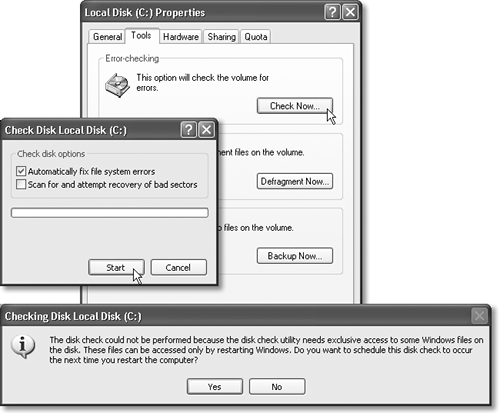16.4 Hard Drive Checkups
| Every time you shut down the computer, Windows tidies up, ensuring all files are saved properly on the drive. When all is well, Windows turns off the machine (or, on older computers, displays a message on your screen telling you it's OK to shut off your computer manually). The time that elapses between your Turn Off Computer command and the actual power-down moment is the "tidying up" period. But sometimes, thanks to a system crash, power outage , or toddler playing with your surge suppressor , your computer gets turned off without warning ”and without the usual shutdown checks. In the days before Windows XP, restarting the PC after such a dirty shutdown would automatically run a program called ScanDisk, a utility designed to detect and, when possible, repair drive damage that may have occurred as a result of an improper shutdown. ScanDisk doesn't exist in Windows XP, but its functions have been reincarnated. You get to this feature by right-clicking the icon of the hard drive you want to check (in the My Computer window). From the shortcut menu, choose Properties; click the Tools tab, and click Check Now (Figure 16-6, top). Figure 16-6. Top: Click Check Now in the Properties dialog box for your hard drive. Middle: Click Start to begin the scan, which checks the file structure, folders, files, and other elements on your drive. Bottom: You may be asked to restart the PC, so that the Son of ScanDisk can do its thing during the startup process. If you click Yes, nothing seems to happen at all. Windows is just holding its breath until you actually restart. During the lengthy procedure, onscreen messages serve up status reports . When it's over, the computer restarts. As shown in the middle of Figure 16-6, a dialog box appears that offers two optional checkboxes:
Before you begin the scan, quit all other open programs; otherwise , Windows will report that it was "unable" to complete the scan. Finally, click the Start button in the Check Disk dialog box to begin the scan. When all phases of the check are complete ("Phase 1, Phase 2"...), a dialog box lets you know how things turned out. NOTE If you elected to format your hard drive with the NTFS file system, described in Section A.4, you'll find hard-drive glitches fixable by ScanDisk and its descendant to be extremely rare, because NTFS drives are designed to be self-repairing. If you still use the FAT 32 formatting scheme, however, it's a good idea to perform this kind of check once every few months, so that it can check your hard drive for any nascent problems. |
EAN: 2147483647
Pages: 230